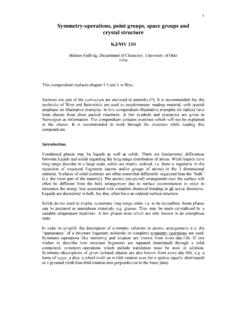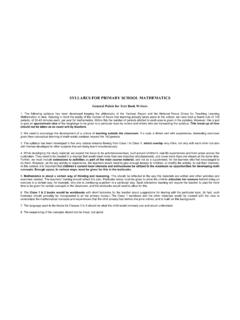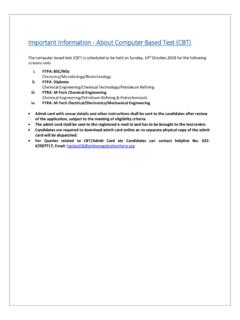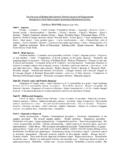Transcription of PUSHING THE BOUNDARIES OF MOTION ANALYSIS
1 PRODUCT DESCRIPTIONTRACKEYE PRODUCT INFORMATIONINTRODUCTIONT rackEye is the world leading system for MOTION ANALYSIS on military test ranges and automotive crash test labs. TrackEye covers the entire process from digitizing images (film or video) through automatic tracking to a complete predefined applications are: 2D, 3D and/or 6D MOTION ANALYSIS on flying objects at military test ranges. The ANALYSIS often involves images from fixed cameras as well as cameras on tracking mounts. 6D ANALYSIS on objects in store separation. The ANALYSIS normally involves images from cameras mounted on wing tips or under the fuselage of an aircraft. 2D and 3D ANALYSIS of different parts of a vehicle during a crash test in the automotive handles all major image file formats from all major high-speed camera manufacturers on the market, mixed or individually. The modular design makes it easy to implement new formats or camera types in thesystem.
2 The icon-based user interface gives a quick and flexible way to design reusable sessions for MOTION ANALYSIS using input from one or several cameras, fixed or moving. External data from GPS, Radar, tracking mount pointing angles and accelerometers can easily be imported and synchronized with the image data. The implemented function-ality handles tracking in several levels, from 2D, 3D and 6D to the most sophisticated range MOTION ANALYSIS tracking THE BOUNDARIES OF MOTION ANALYSISSYSTEM DESCRIPTIONUSING TRACKEYEThe TrackEye system has a state-of-the-art user inter-face that conforms to the Microsoft Windows standard. This makes the interface easy to learn and use. When using the TrackEye system the operator works wthin a session that is managed via the session window. The session window consists of a working area, menus and a function palette where all available functions are pre-sented. The functions are represented by icons.
3 The task of constructing a session is very easy. The operator just chooses a number of icons from the list and connects them into a sequence in the working area. This gives a good overview of what is done and in which order. The result of any change of parameters or functionality in any one function will instantly be available in all other functions in the is no limit to the number of icons that can be used and chained in one session. One session can have several branches operating in figure above is a data flow diagram for the com-plete program. TrackEye handles all stages in the pro-cess from bringing the image data file into the system to the final predefined report containing any number of images, tables, graphs and text. The main parts are described PRODUCT INFORMATIONTRACKEYE SOFTWARE LAYOUTRECORD/LOADIMPORT DECODEIMAGE PROCESSINGTRACKINGCORRECTIONANALYSISPRES ENTATIONEXPORTARCHIVE IMAGE DATAARCHIVE IMAGE DATAARCHIVE IMAGE DATACALIBRATIONLENS DISTORSIONCTMTHEODOLITECINE-SIXTANTCONTR AVESDATA QUALITYDEVELOPER TOOLKITPREFERENCE ARCHIVECOORDINATE SYSTEMTRACKEYE ARCHIVETIME CONTROLVIEWER EXPORTMEDIA-ANALOG FILM-DIGITAL VIDEO-CD-DVD-NETWORKDATAIMAGESRADARPOSIT IONSPLATFORM ANGLESFIELD OF VIEWSCALIBRATIONSMEDIAS AND DATA TYPET rackEye handles many type of different media and data types as input to the tracking TYPES AND FORMATSThe TrackEye software uses digital image sequences as input for the ANALYSIS .
4 A large number of digital for-mats can be read directly during tracking: AVI, TIFF, BMP, JPEG, MPEG2 and many others, including cam-era specific formats. TrackEye continuously develops support for new image formats on the market. Some customers use analog cine film for image storage. The optional TrackEye Film scan-ner can digitize cine film without loss of resolution and present it to the MOTION ANALYSIS software. Please refer to TrackEye Film Scanner product information for de-tails. Standard video (SVHS, Umatic, BetaCam, etc.) can also be brought into the TrackEye by connecting a VCR to an optional frame grabber in the computer. Software for control of the recorder is available as an TYPEST rackEye uses different types of external data for the ANALYSIS and can synchronize data from different sources. Typical data types are: GPS coordinates.
5 TrackEye uses the time stamps provided by a GPS system for synchronization of images and data. Radar positions. TrackEye can use distance mea-sured by radar together with 2D measurement from one camera to generate 3D coordinates. Surveyed positions. Fixed cameras and/or fixed targets are often used in the test. The co-ordinates of the cameras and the targets are sur-veyed prior to the test and transferred to the Track-Eye system. Acceleration data. The automotive industry often uses accelerometers while performing crash tests. TrackEye can import and synchronize this and oth-er test data into the ANALYSIS . Custom data. TrackEye can import any custom data formats and use it in the PRODUCT INFORMATIONLOAD / RECORDINGThe first step in a tracking/ ANALYSIS session is to load data and digitized image information to make it avail-able for the program. This can be done by loading a digitized image file from disk or by recording from VCR or Digital Video.
6 Recorded information can be stored to to each of those and angular information are normally embed-ded in the images from tracking mount TrackEye system automatically decodes the em-bedded information and makes it available for the pro-gram. The system can handle all major types of em-bedded information. New types are added on examples on supported codes are: Video Left Edge Code, FDRS, Analog scales from contrives C and D, Dot Matrix, OCR, IRIG-B and many more. The modularity of the program makes it very easy to include new codes in the PROCESSINGTo improve the image quality for the operator or for the tracking algorithms TrackEye includes image-filtering functionality to improve the quality. Examples of filter functionality in TrackEye is: Image filters: The user chooses between a set of predefined filter kernels or creates his own. Time filters: Adjusts the output sequence with re-spect to one or more previous input sequences.
7 Arithmetic filters: Performs a pixel-by-pixel arith-metic operation between two images or one image and a Cine #2 codeContraves B codeDot matrix codeTRACKING ALGORITHMSTrakEye has a number of different tracking algorithms available for different applications. All take advantage of the tracking framework and track in subpixel resolution. The basic outline tracker analyses threshold values to find the color or grey scale difference between the body and the background. To capture object shapes in test setups with a complex background, an image subtraction can be done. This will convert all non-moving parts of the image into pitch black. The advanced outline tracker looks for edges between different surfaces. This is often used when the color or grey scale difference between the object and the background varies, or when the background is complex and in each successive image for the area that cor-relates best with the pattern defined in the first image.
8 This method is applicable to most cases, as it doesn t require a Finds the symmetry centre of quadrant targets and is invariant to rotation, scale and shading. Quadrant tar-gets are recommended for applications with high de-mands on accuracy and SYMMETRYF inds the symmetry centre of the image within the search area and is applicable to concentric circles, spokes on a bicycle wheel or combinations OF GRAVITYT racks the center of gravity of the contour of a marker or an object. The shape of the target may vary in the sequence and is captured with a user-defined intensity POINTSS pecifies that the point is virtual, its position in suc-cessive images is calculated from the positions of the other points in its target group, rather than by measure-ment. For instance it can be used to define a part of a rigid body that is not visible in the image TRACKERT racks intersection points (corners) on any object shape.
9 The intersections are between extrapolated straight lines applied on the object TRACKERC aptures an object boundary to provide an outline around a body. There are two different outline tracker options; one basic and one TRACKERF inds the symmetry centre of the target. The user can set the target to 1+4 and 1+5 MXT target trackerQuadrant trackerCircular symmetryCenter of gravityIntersection trackerAdvanced outline trackerMXT trackerBasic outline trackerTRACKEYE PRODUCT INFORMATION6 DEGREES OF FREEDOMT racking in 6 degrees of freedom (6 DOF), also known as 6-dimensional (6D) tracking is an optional feature that computes the position and orientation of a rigid body tracked object from a single camera view. The rig-id body must have multiple visible targets at any point in time. The MOTION of the rigid body can be described with six parameters: three position coordinates (x, y and z), which gives the position of a specific point on the body, and three attitude angles (roll, pitch and yaw), which gives its orientation in space.
10 The term 6 DOF refers to these six parameters. TrackEye often refers to these parameters as the 6D position of the body. 3D ANALYSIST rackEye takes the ANALYSIS from 2D on the screen to 3D in the real lab. By tracking the object from two or more cameras, the ANALYSIS is carried out in 3 dimen-sions using the concept of intersection. The target ob-servations (tracked 2D pixel coordinates) and poses of the cameras are used to compute the 3D position of the target as the best fit to the different methods are available to calibrate the camera poses: absolute and relative camera orienta-tion. With absolute orientation a few points with sur-veyed coordinates are used for reference. With rela-tive orientation it is sufficient to identify a few common points of the camera views for reference and add a scale, there is no need for any coordinate measure-ment equipment or cumbersome and restricting cali-bration a consequence, measurement volumes of any size are from moving cameras is supported by tracking the reference points in the image can compute the 6D solution from one or multiple camera views.




